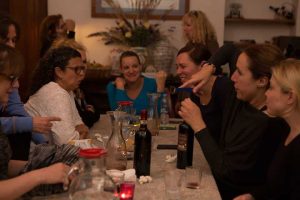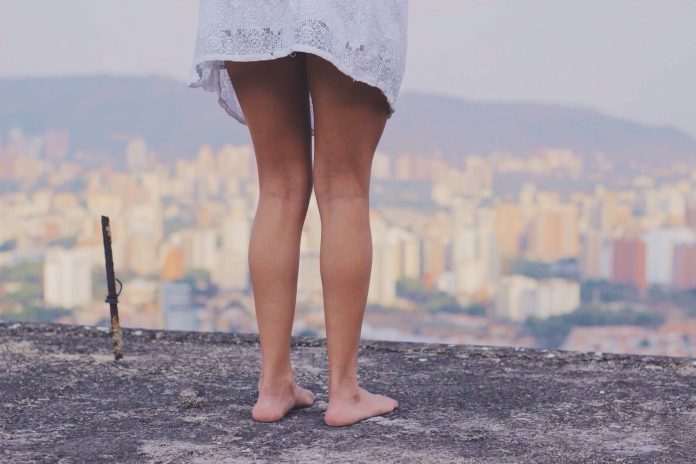By Isabel Abbott
This is what we do now. It is late, and I am in bed, and the lights have long been flicked off along with the day’s clothes which pile in the chair or a trail from front door to white sheets. I am in bed, and I am listening to the sounds outside, locating each one and giving it a name. (Feral cat, two cars passing, a back screen door banging, a low hum of talking while a cigarette is smoked.)
I am listening and I am naming.
I am wanting to sleep.
I am hurting.
There is the slight adjustment, the shift from one side to the next, my left hip a glaring road sign pointing toward the placement of origin for pain. And so this is what we, me and my legs, do now. We lay here, in bed, and at night, unable to sleep, I begin to envision the bones inside, the lock and socket, the strong and soft, the words I imagine are engraved on them, transcribed from all the years I’ve spent walking through the world and street and unmarked alley. All the skin and muscle and bone, the extension and the wrapping around her, the running and running through the woods and the cuts into skin that bled out poison and suffering, the tethering to this earth and the curve of calf when feet slip inside shoes that take me home.
God, they are so truly tremendous.
Is this why it hurts to hurt?
Because of how much good we’ve gone through?
My legs are where the seeker in me lives. Questing, traveling, and traversing. The wandering and roaming and search for the intimate unknown in far off places. Walking is what allows me to be alive and engaged with the world I inhabit, no separation from body and art, as if the very act of moving legs and feet against ground is somehow connected to the creative process of making trails of words into sentences. With the movement of walking, the head clears, thoughts sharpened or else released. The eyes open, and the world becomes a presence my own personhood can relate to and connect with. And I wonder if we would do less violence to the earth and one another if we all had to walk everywhere, see one another, move through the world with love for the legs that release us out and welcome us back, crashing into and around the one we love at night and then bringing us into a waiting world each morning.
We speak a language of legs as walking out and walking away, the leaving, a door slamming on its hinges behind us. But the ten bones from hip to ankle, which is twenty if we count both left and right, is the very map where I find myself, returned. It is where in the movement out and onward, through city street and ocean shore, through Lourdes and Mexico City on the way to her alters, through my own neighborhood and down the back fire escape where my cat comes from, I return back to all of me. It is called pilgrimage. Legs are the language then of love, of a kind of devotion, where we leave to find, and we lose layer after layer on our way to what was always whole.
Whatever one may be leaving, the legs remind that there is no escape. Not of self, which comes with me everywhere. Connected. Tethered. Intimate. And so this is what we do now. Sometimes at night, when I cannot sleep, and it hurts, I imagine the leg inside skin, hip joint where bone against bone is brutal and unkind, and I creating patterns like a kaleidoscope, configuring all the bones and joints into different splayed shapes. What would an X-ray look like of my legs when I stand there in the morning by the counter pressing coffee and trying to remember dreams, one foot planted firmly against hard floor and the other foot arched up so the knee angles out and makes the v shape of a body waiting for cream to splash into coffee?
What would the X-ray reveal of my twelve-year old self right at that moment when feet leave the springboard and the body flies through air before legs come and land against the beam, the colliding of balance and brute strength? What image would configure in the legs in motion, heels clicking again sidewalk and cowboy boots scuffed along dirt and vines where all the trees grow wild? What shape would the bones make when my legs intertwine with hers, fitting together like folded paper cranes, a bed as thick with life as a greenhouse, keeping the cold out while ferns and palms spill out over containers, never once apologizing for space taken and the leg over leg making shapes like waxing moons?
The hurt hurts.
I don’t know yet how to navigate this, really.
How I woke up in so much pain one morning. How I recognized it as bone. “It hurts,” I said. “All the way inside the bone, it hurts.” And then the weeks of doctor’s appointments and insurance exhaustion and my left hip raging pain, moving down the leg, and how every other part of my body then tries to compensate and so clamps down and tightens up and now there is the pain and there are the knots around the pain. And then the X-ray which showed the arthritis. Which is just what happens when you have had cancer so young, and the trail of aftermath that happens once the cure came and told you that you were now free.
Then the specialist who looks at the results and the papers and the charts, and then looks up at me and says what I already half way knew but was pretending we were just going to not mention. That given my symptoms being what they are. Given my history. We have to look at the possibility of cancer. We have to do tests. We have to rule things out before we move forward into management of bones that are trying to find new shapes and ways. And so now there are more tests. There is more waiting. There is this, which is my life.
And I’m thinking now of how the walking is what helps most in the waiting. And so my legs which hurt, need the motion and movement as if it is the medicine itself. The one step after another, the rush of world coming to greet you, the way legs in migration bring me back to the Self I cannot escape. The life I would not want to escape, even though it is one that is in the changing place, a transition that feels both lurching and effortless in its sublimity. I’m thinking that this, then, is what I will do. I will wait. I will keep walking. I will lay in bed at night when I cannot yet sleep and I will let what hurts hurt, and I will imagine the shapes of what is underneath skin and the ways things seek to come apart and converge, creating patterns of ineffable wonder and illuminated memory of when the bones crashed into light.
This is how it happens. This is how trust grows and love takes root. I will listen to myself and believe myself. It hurts. I am listening. I will Believe in the shapes that keep shifting, the soft underside of the knee kissed and the arrow of the limb extended and the silk knot of sitting and the walking and walking and walking.
Sometimes life asks for what we did not see coming. And to respond will take all of us. That is what this moment is. For me. And my legs, this web of roped muscle and coursing veins and bone that is talking to me always. So I said yes, of course, you can be afraid. Yes, it hurts. Yes, I love you. I love you. I love you. I love you. And poured us into a hot bath where the joints loosen and the bones speak and the stories taste like gin and rose, a language of legs in all their injury and lust and love.
Isabel Abbot is a writer and activist, embodiment artist and speaker. An open door to sanctuary and raw reality in birth and death, a lover of the living and unlocking. With a professional background as birth and death doula, a space holder for the mulitvocality of our public and private grief, a sex educator and an embodiment and movement workshop facilitator, She works with those crossing thresholds, questioning their gods, wrestling with their love, grieving and dying into life. Her writing has most recently been published in Bellevue Literary Review, Ars Medica, Elephant Journal, Rebelle Society, and Tattooed Buddha, and Brain Child Magazine. She can be followed on Facebook at facebook: https://www.facebook.com/faith.abbott.921 and on Instagram at https://www.


Get ready to connect to your joy, manifest the life of your dreams, and tell the truth about who you are. This program is an excavation of the self, a deep and fun journey into questions such as: If I wasn’t afraid, what would I do? Who would I be if no one told me who I was?
Jennifer Pastiloff, creator of Manifestation Yoga and author of the forthcoming Girl Power: You Are Enough, invites you beyond your comfort zone to explore what it means to be creative, human, and free—through writing, asana, and maybe a dance party or two! Jennifer’s focus is less on yoga postures and more on diving into life in all its unpredictable, messy beauty.
Note Bring a journal, an open heart, and a sense of humor. Click the photo to sign up.
